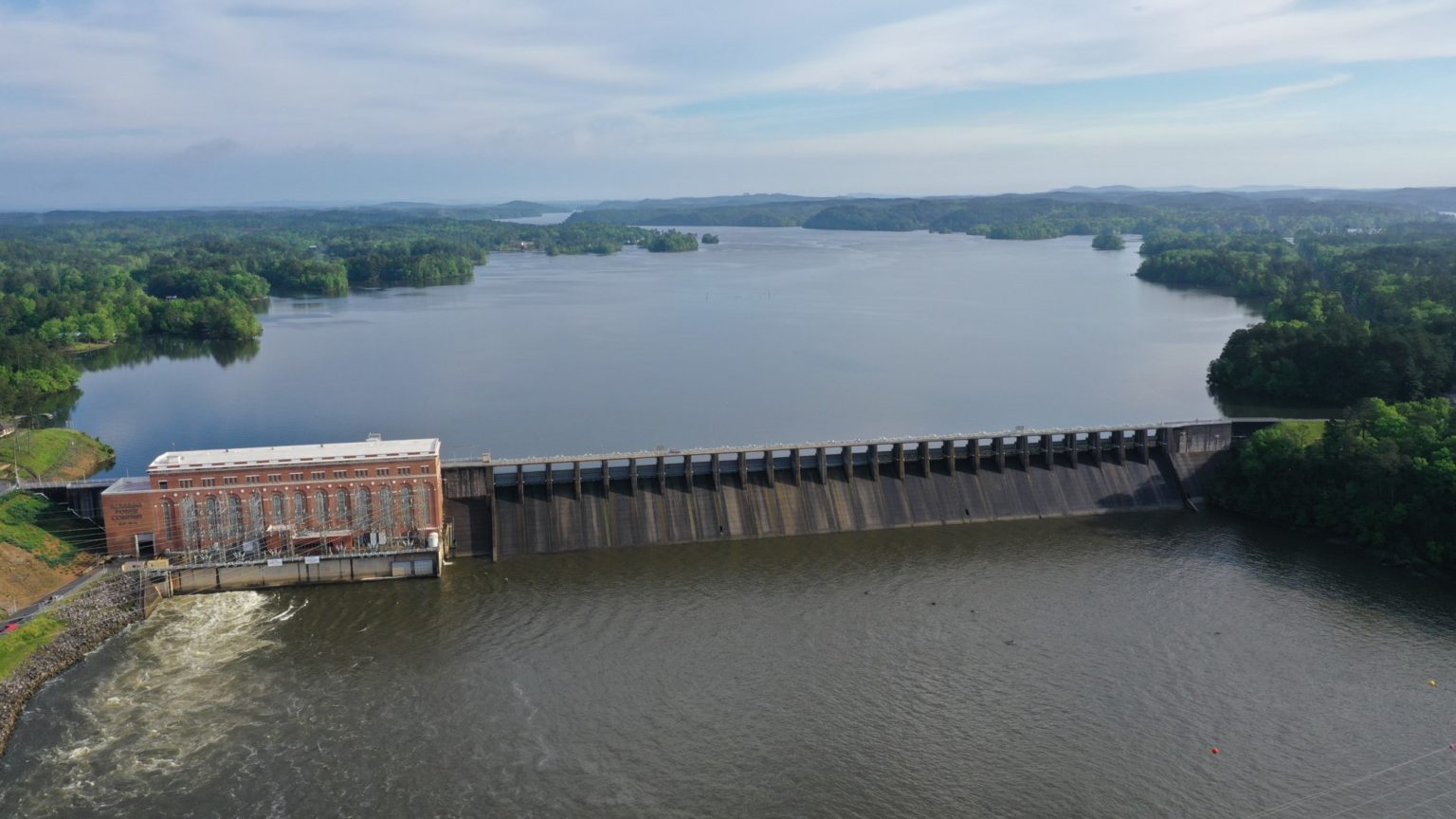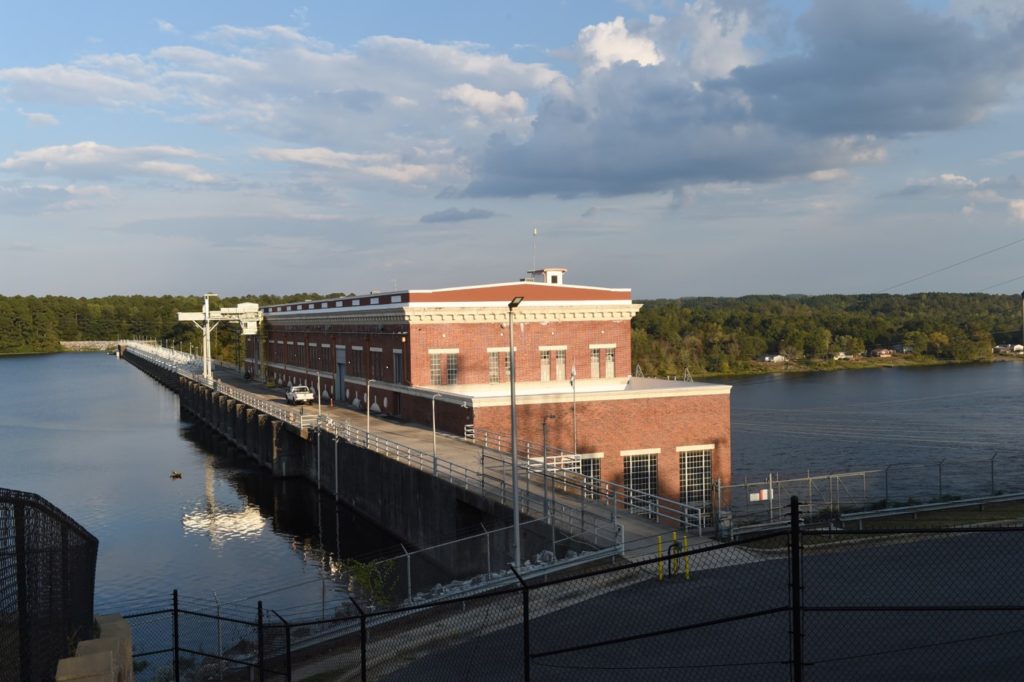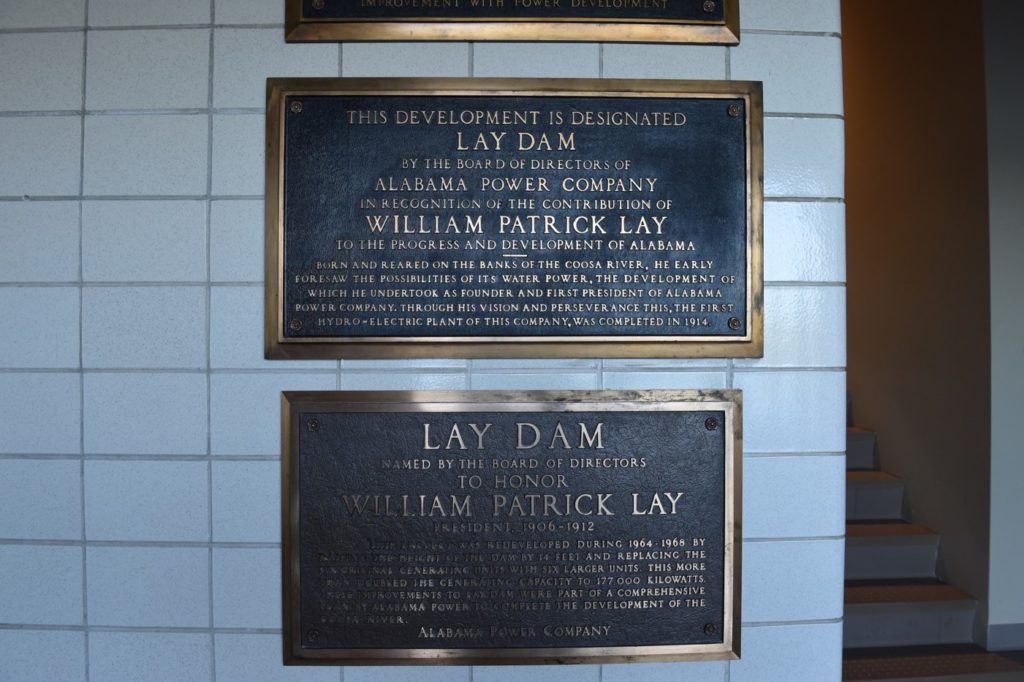
(photo courtesy Alabama Power)
The Lay Dam hydroelectric project was the first dam and hydropower plant built in the U.S. state of Alabama and helped fuel its development. Since it began operating in April 1914, the hydroelectric powerhouse on the Coosa River near Clanton has run more or less continuously, even being significantly upgraded in the 1960s to more than double its generating capacity. The project, originally called Lock 12 and now called Lay Dam in honor of the man who originally proposed its development, was a 2021 inductee into the Hydro Hall of Fame.

This article delves into some of the history behind the development of the 180 MW Lay Dam hydro facility, as well as Alabama Power’s other hydroelectric projects.
The early years of Alabama Power
Between 1912 and 1928, the Alabama Power Company built four hydroelectric dams on the Coosa and Tallapoosa rivers. At the time, and for some time to come, these dams were the largest, most complex and most expensive construction projects in the history of the state. But they were much more than that. The dams were a turning point. When their turbines began spinning and electricity began to flow from the powerhouses to farms, towns and cities, Alabama moved from the 19th into the 20th century. The state and its people would never be the same again.
Just over a year after construction began, Lay Dam was completed near Clanton. The project, the first hydroelectric plant to be built by Alabama Power, was launched in 1910 by William Patrick Lay, a native of Gadsden. When the project ran into financing difficulties, Lay turned to developer James Mitchell, who helped secure investment from London to form the holding company Alabama Traction, Power & Light Company, a precursor of Alabama Power. Eventually, Lay gave up ownership in the company to Mitchell. Constructed by workers who lived in a company village on site, the plant went into service in April 1914. Having been extensively renovated in 1967, the plant continues to serve customers today. Lay Lake includes 289 miles of shoreline that provides recreational opportunities such as boating, fishing, swimming and picnic space for the public.

Lay Dam and powerhouse on the Coosa River
Prior to 1912, only 72 Alabama communities had electricity. But by 1928, when Jordan Dam went into operation, Alabama Power served 421 communities in 61 of Alabama’s 67 counties. The company also provided power for coal and iron ore mills, cotton mills, cement plants, quarries, steel plants, public utilities, and electric furnace installations, industries that put thousands of citizens to work.
Alabama Power lit up the lives of countless Alabamians. Meager records make it impossible to know how many individuals actually had electricity before 1912, but apparently the number was small. However, once Lay Dam went on line and Alabama Power began expanding its generation and distribution facilities, the number of consumers grew rapidly. By 1919, the company had over 10,000 customers, and that number had nearly doubled three years later. Then Mitchell Dam began operation, and before 1923 was out over 35,000 were being served. That same year, marketing efforts broadened when the company, “with associated local firms,” opened Alabama’s “first electrical home” in Selma, and citizens saw what the future held in store. They liked what they saw, and by 1926 over 60,000 had signed up. The number continued to rise until the end of the decade.
Most of this expanding market, however, was in the towns and cities, which presented a public relations problem for the company because most Alabamians still lived on farms. The charge that Alabama Power was ignoring the needs of the majority was a sensitive issue at corporate headquarters, and by 1923 the company had worked out an arrangement with Alabama Polytechnic Institute at Auburn to support research “to find practical means and methods of supplying electric service to the farmers.”
It was recognized that in order for Alabama Power to make a profit on rural service, farmers would have to be shown how they could use electricity for purposes other than lighting. The electrification of the agricultural experiment station was the first step, and in each subsequent Annual Report the company told of the progress being made. Slowly but steadily, more rural lines were added, and by 1926 Alabama Power was serving over 6,000 agricultural customers.
It was, however, a small start, and company officials knew that electricity would not “be a cure-all for the various ills which at present afflict farm life.” Still, Alabama Power believed that “the intelligent distribution and use of electrical power on the farm should lessen drudgery, make farm life more attractive and increase production per man, thereby increasing wealth and aiding the reduction of tenant farming.” Country folks were willing to give it a try, if they could get a line to their houses and prices they could afford. But for many that would be a long time coming, and Alabama farms would continue to be lit by the glow of kerosene lamps and lanterns.
How the 1920s altered history
By the end of the 1920s, Alabama Power had transformed the face of Alabama, but in the less than two decades since it came under the control of James Mitchell and Thomas Martin, the company had been transformed as well. Alabama Power was now a mature corporation, with thousands of employees and with plans for the future but it would be a long time before dreams of more dams on the Coosa and Tallapoosa would become a reality.
In 1929, just as Jordan was coming online, the American economy collapsed. Projects already financed were carried out, but most had to be shelved. Years would pass before Alabama Power hired hundreds of construction workers again. The Depression took its toll at all levels. Men and women in the offices were laid off as the company cut expenses to the bone, while down at the dams operations were carried on with skeleton crews. The APC Club — with “an outdoor playground and common meeting place for all employees interested” at Lake Mitchell — was also a victim of the Depression, as those who had jobs held onto their money and stayed close to home.
Now the villages for dam employees and their families did become little worlds unto themselves, where residents rallied to help each other weather the crisis. They still held dances from time to time; the schools still operated; and there were occasional parties and picnics, especially for the children. But visitors were fewer now, and the entertainment for them was less lavish. Still, those who lived there had jobs, nice houses and amenities that their counterparts in Calera, Verbena and Clanton lacked. Little wonder that, looking back, people who lived out in the counties thought Alabama Power employees were among the most fortunate in the state.
If citizens from outside the reservation were a little jealous of “dam folks,” they probably realized that their own circumstances surely would have been far worse if Alabama Power had not come into their communities and built those dams. And they also surely realized that had it not been for the electricity being sent out to towns, cities and factories, the impact of the Depression on all Alabama’s citizens would have been far greater than it was.
In fewer than two decades of frantic activity, the Alabama Power Company had harnessed the Coosa and Tallapoosa and had put those “loafing streams” to work. What might have been accomplished, had it not been for the depression, will never be known. What was accomplished before the crisis came continues to be a source of amazement.
Celebrating a centennial
In 2014, the centennial of Lay Dam’s operation, environmental compliance engineer Bill Gardner worked to honor and preserve the history and memories of the building of the dam and life at the company village. He was working to meet FERC hydro license requirements to document the historic properties along the Coosa River, including the company village. Gardner said that they “want to illustrate the vibrancy of the village and encompass the lives of the workers and families that lived there.”

Naming plaque for Lay Dam, formerly called Lock 12
Gardner studied maps and sketches to identify where buildings and homes were located, researched historical documents, managed archaeological testing throughout the site, and interviewed current and past employees to learn more about the dam operations and life in the company village.
“While Alabama Power had maps and architectural drawings, it has been the stories and photographs from personal collections that have been crucial in piecing together the history of life in the village,” Gardner said.
As part of the documentation process, Environmental Compliance and the Alabama Power Corporate Archives reached out to current and former employees to obtain photographs, artifacts and stories about the Lay Dam and village. Corporate Archives is preserving the information that was received for future generations.